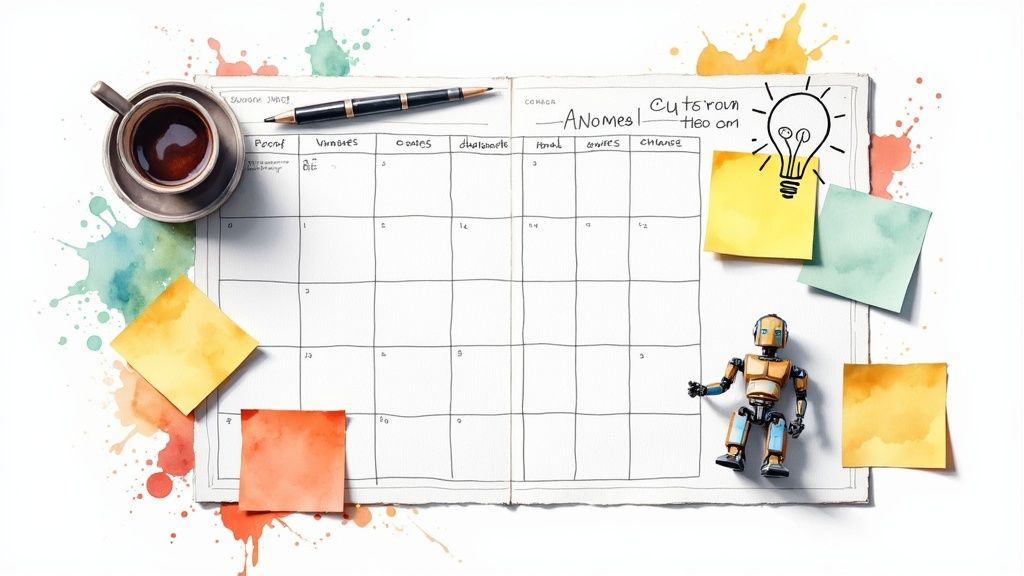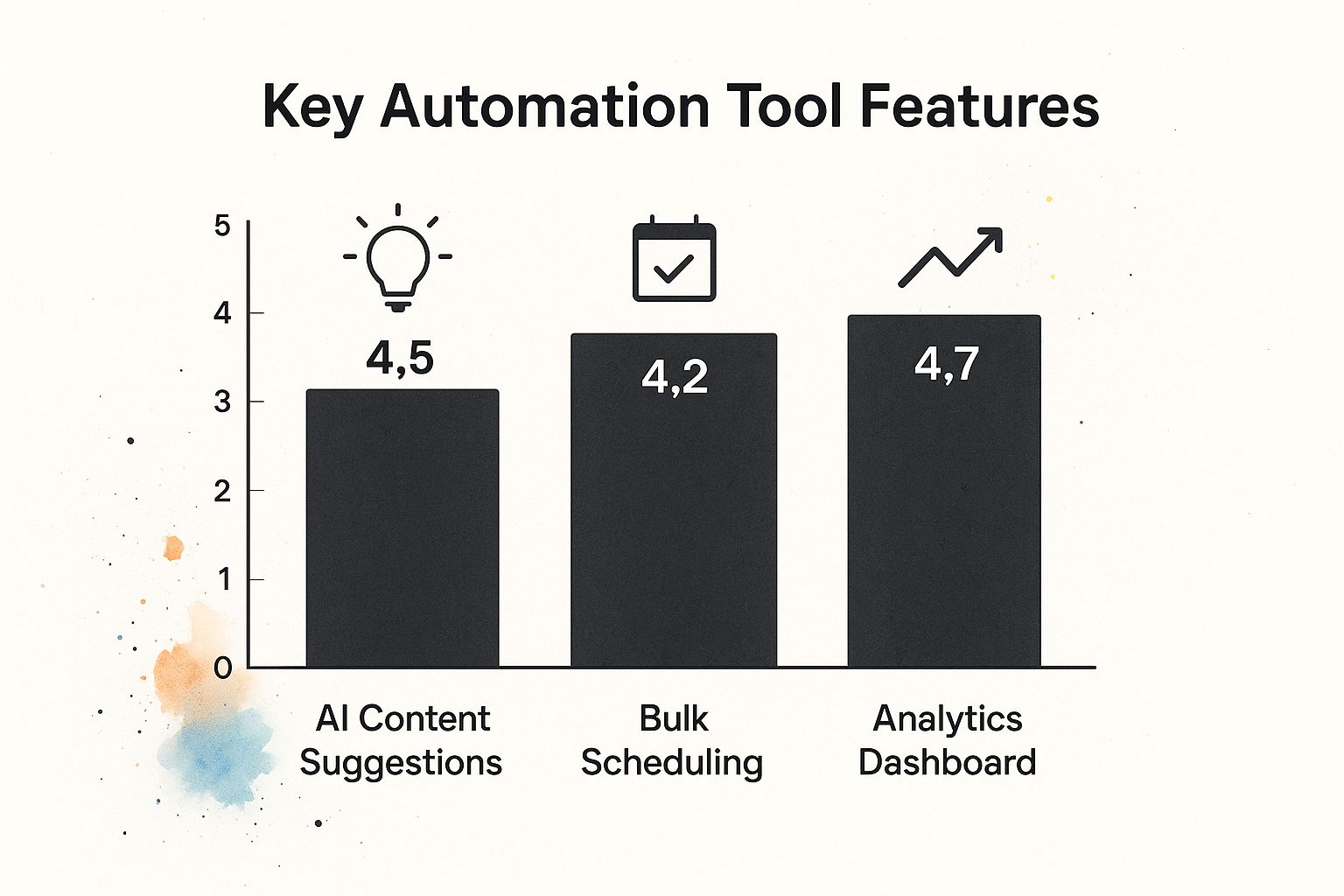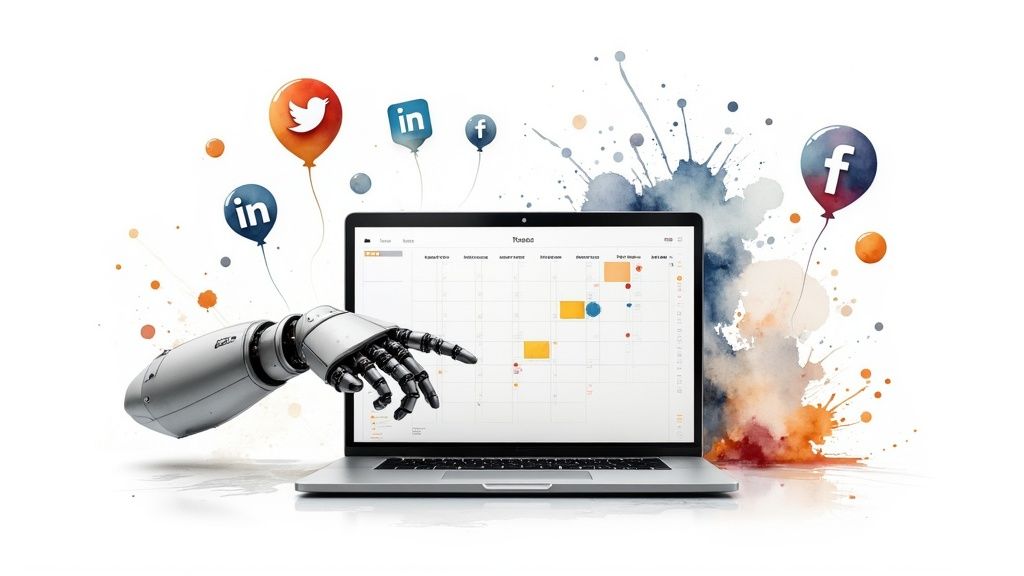Automated social media posting is pretty straightforward: it's using software to line up and publish your content across different platforms without you having to manually hit "post" every single time. This approach does more than just save a few minutes here and there. It's a fundamental shift that turns a repetitive, time-draining task into a powerful part of your business strategy, freeing up your team to actually talk to people and focus on growing your brand.
Why Social Media Automation Is Essential Now
Let’s be honest, posting everything by hand is no longer a realistic strategy. The sheer amount of content you need to push out to stay relevant across different platforms will burn out even the most dedicated social media manager. This is where automated social media posting stops being a "nice-to-have" and becomes a critical tool for staying competitive. It’s all about creating a smart, reliable system that gets the right message in front of the right people, at the right time, every single time.
This isn't just about loading up a queue and forgetting about it. Modern tools like Rebelgrowth give brands the power to maintain a high-quality, consistent stream of content that would be physically impossible to manage manually. The real win here is getting back your time and mental energy—resources you can pour back into things that actually move the needle, like engaging with your community and planning your next big move.
The Shift From Manual Effort To Automated Advantage
By 2025, the digital world is expected to have over 5.45 billion social media users. Trying to keep up with that manually is a losing battle. On average, marketers who automate their social media content save about six hours a week. That adds up to more than 300 hours a year—time that can be spent building customer relationships and digging into campaign data. Automation isn't just about efficiency; it's a clear strategic advantage.
The table below really drives home the difference between grinding it out manually and working smarter with automation.
Manual Effort vs Automated Advantage
| Benefit | Manual Posting Approach | Automated Posting Advantage |
|---|---|---|
| Consistency | Inconsistent posting times, prone to human error and missed opportunities. | Posts are published at optimal, pre-scheduled times, ensuring a constant presence. |
| Efficiency | Extremely time-consuming; requires daily, hands-on management. | Frees up hours per week, allowing focus on strategy and engagement. |
| Scalability | Difficult to manage multiple platforms or increase post frequency. | Easily scales across various networks and campaigns without extra manpower. |
| Analytics | Data is scattered across platforms and requires manual compilation. | Centralized dashboards provide clear, actionable insights for quick optimization. |
As you can see, the benefits go far beyond just saving time. Automation fundamentally changes what you're capable of achieving with your social media presence.
Building a Smarter, More Efficient Workflow
Really getting the most out of automation means thinking bigger than just scheduling posts. To make your social strategy truly effective, it helps to understand some core marketing automation best practices that apply across the board. This bigger picture ensures your social efforts are actually supporting your main business objectives, not just making noise.
AI-driven platforms like Rebelgrowth, for example, can help you generate and schedule content all in one place.

A dashboard like this is a game-changer. It brings content creation, scheduling, and analytics together, turning a chaotic process into a streamlined workflow. When you adopt a system like this, you stop just posting and start executing a deliberate, data-backed strategy. For more ideas on leveling up your content game, check out the resources over on the Rebelgrowth blog.
Building Your Automated Content Blueprint

Jumping straight into social media automation without a plan is like trying to build a house without a blueprint. You'll end up with a mess of generic, ineffective content. Before you let any AI tool near your calendar, you need to map out a clear strategy.
This blueprint is what guides your tools, making sure every single post has a purpose and pushes your goals forward—not just fills up space.
First things first: what are you actually trying to achieve? Is it about generating leads? Building a loyal community? Or just getting your brand name out there? Your primary goal sets the entire tone for what comes next.
For example, a business hungry for leads will push content that drives traffic to specific places. A big part of that is creating high-converting landing pages designed to grab visitor details. On the flip side, a brand focused on community will be all about sparking conversations and sharing user-generated content.
Establish Your Content Pillars
With your goal locked in, it's time to lay the foundation with content pillars. These are the 3-5 core topics your brand will own and talk about consistently. Think of them as the main categories of your blog; they keep your message tight and ensure you’re always speaking to your ideal audience.
For a B2B software company, these pillars might look something like this: * Productivity Hacks: Actionable tips that help their audience get more done. * Industry News & Analysis: Smart takes on trends their customers care about. * Customer Success Stories: Real-world proof of how their software solves problems. * Product Updates & Features: What's new and how to get the most out of it.
This structure stops your feed from feeling random. It builds your authority and tells followers exactly why they should stick around, making your automated posts feel intentional and strategic.
Create a Balanced Content Mix
Once your pillars are defined, you need to figure out the right mix of content. One of the biggest mistakes I see is brands being way too promotional. A solid guideline is the 80/20 rule: 80% of your content should be genuinely valuable (it educates, entertains, or inspires), and only 20% should be a direct sales pitch.
A great automation strategy doesn't kill the human touch—it scales it. The tech handles the scheduling and grunt work, freeing you up to focus on the creative ideas and genuine connection that actually matter.
Let’s see how this plays out for two totally different businesses.
B2B Software Company (Goal: Lead Generation) * 50% Educational: Snippets from blog posts, industry reports, how-to guides. * 30% Engaging: Polls about common workplace frustrations, questions to stir up discussion. * 20% Promotional: Webinar sign-ups, demos of new features, links to case studies.
D2C Fashion Brand (Goal: Community Building) * 40% User-Generated Content: Showing off customer photos and testimonials. * 40% Inspirational: Style guides, behind-the-scenes content, trend reports. * 20% Promotional: Announcing new collection drops, flash sales, and specific product features.
With this blueprint in hand, an AI tool like Rebelgrowth gets a crystal-clear directive. It isn't just churning out random posts. It's creating content that fits perfectly within your pillars and follows your strategic mix, turning your automation from just efficient to incredibly effective.
Choosing the Right Automation Platform
With a solid content blueprint ready, the next move is picking the right tool to bring your automated social media posting strategy to life. The market is flooded with options, but trust me, not all platforms are created equal. Making the right choice really boils down to finding the features that line up with your specific goals, team size, and budget.
Think of it this way: choosing a platform is like hiring a digital employee. You need one that’s not just efficient but also smart enough to help you improve over time. You've got to look beyond basic scheduling and focus on functionalities that offer a real strategic advantage.
This means finding a tool with AI-powered content suggestions to help you break through creative blocks, an intuitive bulk scheduler that can save you hours of grunt work, and integrated analytics that turn raw data into genuinely useful insights. These are the core features that form the engine of a powerful automation system.
Core Features That Drive Success
When you start comparing platforms, three features consistently stand out as non-negotiable for serious marketers. These are the tools that separate a simple scheduler from a true growth machine.
- AI Content Suggestions: Modern tools can analyze trends and your own past performance to suggest post ideas, generate captions, or even create entire posts from scratch. This is a game-changer for maintaining a fresh, relevant content pipeline without burning out your creative team.
- Intuitive Bulk Scheduling: The ability to upload and schedule dozens—or even hundreds—of posts from a single file is a massive time-saver. This is absolutely essential for planning content weeks or months ahead, ensuring you stay consistent even during your busiest periods.
- Integrated Analytics Dashboard: A good platform won't just post for you; it'll show you what's working and what's not. A centralized dashboard that tracks engagement, reach, and click-through rates across all your networks is crucial for tweaking your strategy on the fly.
This infographic highlights just how important these features are to real users when they're picking a tool.

The data is pretty clear: a strong analytics dashboard is rated as the most critical feature. It really underscores the need for data-driven decision-making in any automation strategy you build.
Essential Automation Tool Feature Checklist
When you're wading through all the options, it's easy to get sidetracked by flashy features that don't actually move the needle. This checklist will help you cut through the noise and focus on the functionalities that truly matter for efficiency and growth.
| Feature | What It Does | Why It Matters for Your Strategy |
|---|---|---|
| Bulk Scheduling | Allows you to upload and schedule a large number of posts at once, often from a CSV or spreadsheet. | Saves countless hours and ensures a consistent posting cadence weeks or months in advance. |
| AI Content Generation | Uses AI to suggest or create post ideas, captions, and hashtags based on trends and your history. | Fights creative burnout and keeps your content pipeline full of fresh, relevant ideas. |
| Cross-Platform Analytics | Provides a single dashboard to track key metrics (engagement, reach, clicks) across all networks. | Offers a clear, unified view of what's working, enabling you to make smarter, data-backed decisions quickly. |
| Social Inbox | Consolidates comments, DMs, and mentions from all connected accounts into one manageable feed. | Drastically improves response times and ensures you never miss an opportunity to engage with your audience. |
| Content Curation/RSS Feed | Automatically pulls in relevant articles and content from other sources for you to share. | Helps you easily supplement your original content with valuable industry news, keeping your feed active. |
| Evergreen Content Recycling | Automatically re-shares your best-performing posts at set intervals to maximize their lifespan. | Drives continuous traffic and engagement from your top content without any extra manual effort. |
Use this table as your guide. If a tool you're considering is missing a few of these key features, think hard about whether it can truly support your long-term goals.
Advanced Capabilities and Configuration
Once you've vetted the basics, start looking for the advanced features that can give you a real edge. For instance, leading platforms like SocialPilot and Agorapulse allow users to bulk schedule up to 500 posts, automate the sharing of evergreen content, and pull in articles from RSS feeds to distribute across networks. These platforms also offer sophisticated social inbox management and deep marketing analytics, with pricing typically ranging from $30 to $200 per month depending on your needs. For a detailed breakdown, you can explore more insights about social media automation tools.
The best automation tools don't just execute tasks; they provide the intelligence you need to make smarter marketing decisions. Your goal is to find a platform that acts as a strategic partner, not just a scheduler.
After you've made your choice, the setup process is usually pretty straightforward. You’ll start by securely connecting your social media accounts. Then, using that content blueprint you already created, you can start mapping out your first content calendar. This means setting up posting schedules for each network, creating content categories based on your pillars, and loading your first batch of posts. This initial configuration is where your strategy truly comes to life, turning your plan into a fully operational, automated system.
Making Your Automated Posts Feel Human

Let's be honest: the biggest hang-up people have with automated social media posting is the fear of sounding like a robot. It's a valid concern. If your feed becomes a sterile, predictable stream of scheduled content, you'll lose the very audience you're trying to build.
The secret is to see automation as an assistant, not a replacement.
Your goal is to use these powerful tools to handle the heavy lifting—the repetitive stuff—freeing you up to do what humans do best: connect, engage, and react in the moment. This means adopting a "set it and still check it" mindset. Automation is for consistency; your real-time presence is for community.
Customize Content For Each Platform
One of the fastest ways to scream "I'm a bot!" is lazy cross-posting. Blasting the exact same message across every single platform is a dead giveaway.
LinkedIn is not Instagram, and Instagram is definitely not X (formerly Twitter). Each network has its own vibe, its own audience, and its own unspoken rules.
Instead of a one-size-fits-all approach, use your automation tool to customize. A single piece of content can be spun in a few different ways:
- LinkedIn: Frame your post as a professional insight or a business lesson. The tone should be a bit more formal, and you'll want to use relevant industry hashtags.
- Instagram: It's all about the visual. Lead with a high-quality image or video, and write a caption that's engaging and conversational to encourage comments and saves.
- X (Twitter): Boil the core idea down into a short, punchy thought. Can you add a relevant meme or ask a question to spark immediate reactions? Do it.
This small extra step shows you respect each platform's culture and that you actually understand how people communicate there.
Blend Evergreen and Timely Content
Think of your automated queue as the backbone of your strategy. It should be filled with high-quality evergreen content—posts that stay valuable and relevant long after they're published. We're talking how-to guides, foundational tips, and brand stories. This ensures your feed is never empty.
But you have to leave room for spontaneity.
When a major industry event happens, or a relevant meme starts trending, you need to jump on it. Pausing your automated schedule to drop a timely, relevant post shows you’re paying attention. It’s this blend of planned and reactive content that makes a brand feel alive.
Automation should fuel your engagement, not replace it. The time you save on scheduling is time you should reinvest into replying to comments, joining conversations, and building genuine relationships with your followers.
Automation Powers Real-Time Engagement
The way modern marketing teams work is being completely re-shaped by automation. It’s not just about scheduling posts anymore.
Advanced platforms can now help teams automatically moderate nearly half of their social media comments, which can save up to 175 hours per month on engagement management alone. With 48% of consumers interacting more with brands on social media, this kind of help is essential for keeping up. You can dig deeper into how automation is changing marketing workflows to see the full picture.
Ultimately, your success with automated posting comes down to finding that balance. Use the tools to nail your scheduling and consistency, but always be the human behind the curtain, ready to engage in real-time.
How to Measure and Refine Your Strategy
The real magic of automating your social media isn't just about saving time—it's about the data you get back. This is where you shift from guessing what might work to knowing exactly what does, turning your strategy into a well-oiled growth machine.
Think of your analytics dashboard as a direct line to your audience. It shows you which posts get people talking, which ones drive clicks, and which ones, well, don't. This constant feedback is what you need to make quick, smart decisions instead of flying blind.
Pinpointing Your Key Performance Indicators
Before you can get better, you have to know what you’re measuring. It’s easy to get caught up in vanity metrics like follower counts, but those numbers don't always help your bottom line. The trick is to zero in on the Key Performance Indicators (KPIs) that actually map to your business goals.
These are the metrics that truly move the needle:
- Engagement Rate: This is your audience's pulse. It bundles likes, comments, shares, and saves to show you who’s actually interacting with your content versus just scrolling by. A healthy engagement rate is a clear sign your message is hitting the mark.
- Click-Through Rate (CTR): This one's simple: how many people clicked a link in your post? If you’re trying to get people to your blog or a sales page, CTR is your most important KPI.
- Reach and Impressions: Reach is the number of unique people who saw your post. Impressions are the total number of times it was seen. Both are essential for tracking how far your brand's voice is traveling.
- Conversions: For most of us, this is the ultimate goal. It tracks how many people took a specific action you wanted, like signing up for a newsletter or buying a product after clicking through from your post.
The most valuable thing you can do is figure out why certain posts take off. Was it the format (video kills it every time?), the topic, the caption's tone, or the time you posted? The answers are sitting right there in your analytics.
Focusing on these specific data points lets you move past surface-level stats and start drawing a straight line from your social media activity to real business results. For a deeper look at tying your efforts to outcomes, it's worth learning more about how to measure marketing campaign success.
Turning Insights Into Actionable Improvements
Data is just noise until you do something with it. Make it a habit to block off time each month to dig into your performance and use what you find to make real changes to your content calendar.
Start looking for obvious patterns in your dashboard. Are your video posts pulling in 3x the engagement compared to static images? Does your audience seem most active between 9-11 AM on weekdays? These aren't just interesting facts; they're your roadmap.
Use this info to test out new ideas and fine-tune your automated posting schedule. If you find that how-to guides are driving a ton of clicks, start weaving more of them into your content mix. Or, if your posts are getting traffic but no one's converting, maybe it's time to give your landing pages a refresh.
Another piece of this puzzle is making sure your site is optimized for search engines. Our free AI SEO checklist can walk you through how to align your content with what people are actually looking for. This is how your automation strategy stops being static and starts learning and improving, pushing for better results every single month.
Common Questions About Social Media Automation
Jumping into social media automation definitely brings up a few questions. And that's a good thing—it’s smart to kick the tires before you hand over the keys to your content calendar. Let's tackle some of the biggest concerns I hear from people all the time.
The goal isn't to replace the human touch; it's to get rid of the repetitive stuff so you have more time to actually connect with people.
Will Automated Posting Make My Brand Sound Like a Robot?
This is the number one fear, and I get it. But it's completely avoidable if you're smart about it. Automation is a tool for execution, not creation. The actual content—the words, the ideas, the personality—that all has to come from you, crafted in your unique voice long before it ever gets scheduled.
The trick is to sidestep the lazy, "post-everywhere" approach. Instead, you'll want to:
- Tailor content for each network. What you post on LinkedIn should feel totally different from what you share on Instagram. It’s a simple rule, but one so many people forget.
- Keep engaging in real-time. Let automation handle your planned-out, evergreen content. That frees you up to jump into trending topics and conversations as they happen.
- Focus automation on your core content. Think of it as the engine for your foundational stuff—blog posts, weekly tips, and key brand messages.
When you do it this way, your feed feels intentional and authentic, not like it’s being run by a machine.
Automation should be the engine that powers your consistency, not the voice that speaks for your brand. That part is, and always will be, human.
How Often Should I Be Posting?
Honestly, there's no single magic number. Anyone who tells you "post 3 times a day" is just guessing. The right frequency really boils down to two things: the platform you're on and your audience's behavior.
For example, X (formerly Twitter) is a firehose of content; you can post several times a day and it feels completely normal. But try that on LinkedIn, and you'll probably just annoy your network and kill your reach.
Your best bet is to start with the established best practices for each network, then watch your analytics like a hawk. Your engagement data will tell you exactly when and how often your specific audience wants to hear from you.
Can I Automate Comments and Replies Too?
You can, and many of the newer tools have features for automating basic replies and comment moderation. This can be a lifesaver for handling things like spammy comments or answering the same simple questions over and over, like "What are your hours?"
But—and this is a big but—you have to use this feature carefully. It's brilliant for managing the high-volume, low-effort interactions. However, genuine conversations, customer service problems, or detailed questions always, always need a real person to step in.
The best strategy is to let automation handle the repetitive stuff, which buys you back time for the meaningful, one-on-one engagement that truly builds a community.
Ready to transform your social media workflow and get back hours of your week? With rebelgrowth, you can use AI to generate, schedule, and analyze your social media content all in one place. Start automating your growth today!
